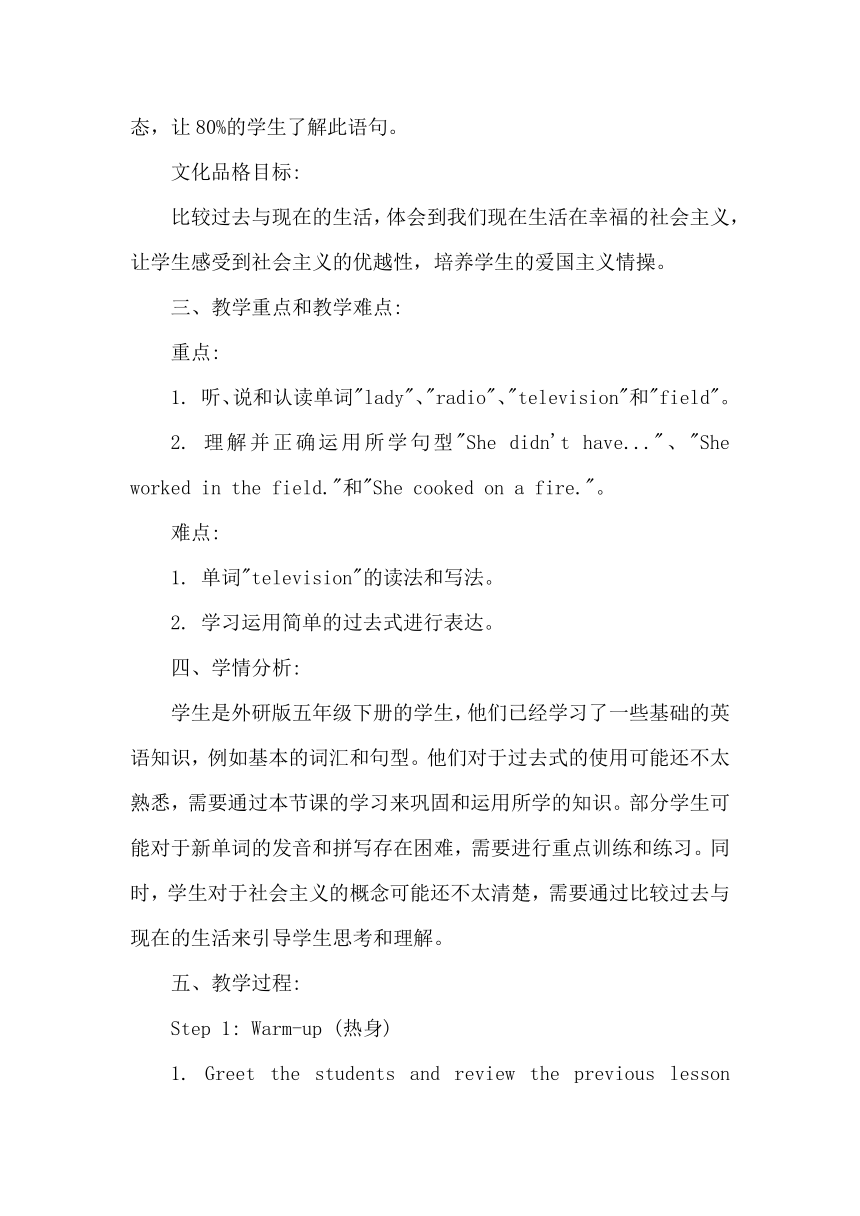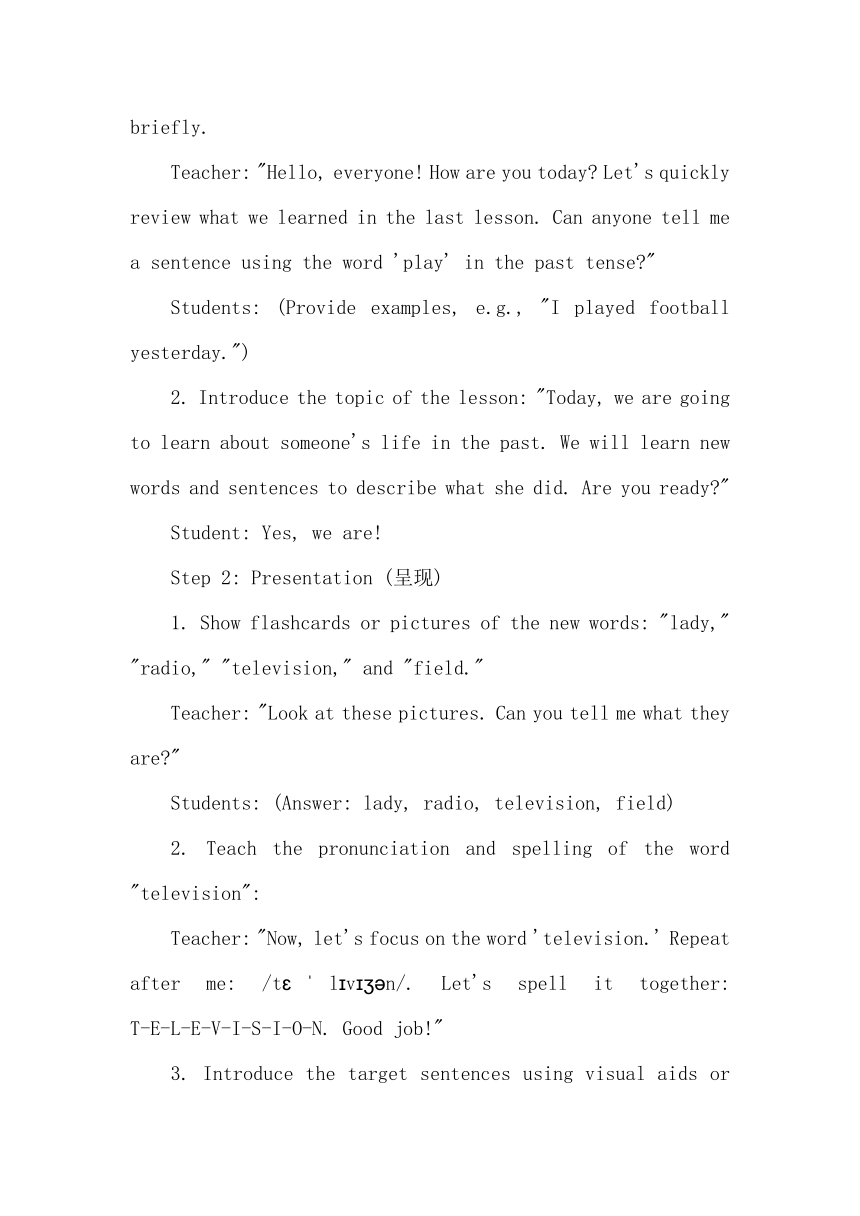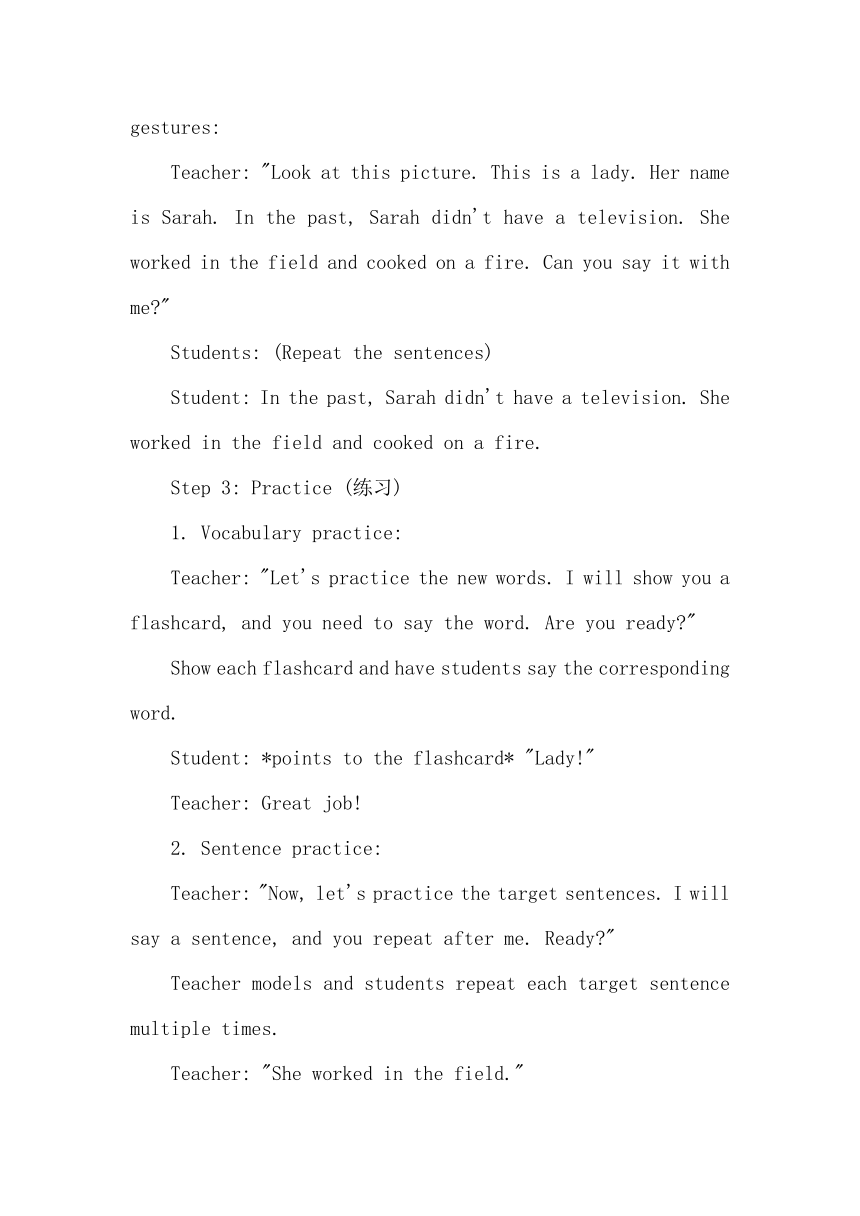Module 1 Unit 2 She didn't have a television.教案(含教学反思)
文档属性
| 名称 | Module 1 Unit 2 She didn't have a television.教案(含教学反思) |  | |
| 格式 | docx | ||
| 文件大小 | 14.5KB | ||
| 资源类型 | 教案 | ||
| 版本资源 | 外研版(三年级起点) | ||
| 科目 | 英语 | ||
| 更新时间 | 2024-03-22 14:19:48 | ||
图片预览




文档简介
外研版五年级下册英语Module 1
《Unit 2 She didn't have a television.》教案
一、教材分析:
本节课是外研版五年级下册Module 1《Unit 2 She didn't have a television.》的第一课时,主要围绕过去发生的事情展开。教材中引入了新单词"lady"、"radio"、"television"和"field",并提供了句型"She didn't have..."、"She worked in the field."和"She cooked on a fire."用于描述过去的生活情景。通过本节课的学习,学生将能够掌握这些新单词的读音和意义,学会运用一般过去时来描述过去的事情。
二、教学目标:
语言知识目标:
1. 能够认读单词"lady"、"radio"、"television"和"field",并能够利用小老师的操练方法,达到90%的学生基本掌握本课词汇,并能够灵活运用。
2. 理解本课的目标语句"She didn't have..."、"She worked in the field."和"She cooked on a fire.",通过创设的情景,让95%的学生能够领悟目标语句,并学会表达。
思维能力目标:
能够运用所学的一般过去时来描述过去发生的事。
学习能力目标:
能够灵活运用功能语句在真实的生活情景中谈论过去的生活状态,让80%的学生了解此语句。
文化品格目标:
比较过去与现在的生活,体会到我们现在生活在幸福的社会主义,让学生感受到社会主义的优越性,培养学生的爱国主义情操。
三、教学重点和教学难点:
重点:
1. 听、说和认读单词"lady"、"radio"、"television"和"field"。
2. 理解并正确运用所学句型"She didn't have..."、"She worked in the field."和"She cooked on a fire."。
难点:
1. 单词"television"的读法和写法。
2. 学习运用简单的过去式进行表达。
四、学情分析:
学生是外研版五年级下册的学生,他们已经学习了一些基础的英语知识,例如基本的词汇和句型。他们对于过去式的使用可能还不太熟悉,需要通过本节课的学习来巩固和运用所学的知识。部分学生可能对于新单词的发音和拼写存在困难,需要进行重点训练和练习。同时,学生对于社会主义的概念可能还不太清楚,需要通过比较过去与现在的生活来引导学生思考和理解。
五、教学过程:
Step 1: Warm-up (热身)
1. Greet the students and review the previous lesson briefly.
Teacher: "Hello, everyone! How are you today Let's quickly review what we learned in the last lesson. Can anyone tell me a sentence using the word 'play' in the past tense "
Students: (Provide examples, e.g., "I played football yesterday.")
2. Introduce the topic of the lesson: "Today, we are going to learn about someone's life in the past. We will learn new words and sentences to describe what she did. Are you ready "
Student: Yes, we are!
Step 2: Presentation (呈现)
1. Show flashcards or pictures of the new words: "lady," "radio," "television," and "field."
Teacher: "Look at these pictures. Can you tell me what they are "
Students: (Answer: lady, radio, television, field)
2. Teach the pronunciation and spelling of the word "television":
Teacher: "Now, let's focus on the word 'television.' Repeat after me: /t l v n/. Let's spell it together: T-E-L-E-V-I-S-I-O-N. Good job!"
3. Introduce the target sentences using visual aids or gestures:
Teacher: "Look at this picture. This is a lady. Her name is Sarah. In the past, Sarah didn't have a television. She worked in the field and cooked on a fire. Can you say it with me "
Students: (Repeat the sentences)
Student: In the past, Sarah didn't have a television. She worked in the field and cooked on a fire.
Step 3: Practice (练习)
1. Vocabulary practice:
Teacher: "Let's practice the new words. I will show you a flashcard, and you need to say the word. Are you ready "
Show each flashcard and have students say the corresponding word.
Student: *points to the flashcard* "Lady!"
Teacher: Great job!
2. Sentence practice:
Teacher: "Now, let's practice the target sentences. I will say a sentence, and you repeat after me. Ready "
Teacher models and students repeat each target sentence multiple times.
Teacher: "She worked in the field."
Students: "She worked in the field."
3. Pair or group work:
Teacher: "Now, I want you to work in pairs or groups. Take turns asking and answering questions using the target sentences. For example, ask 'Did she have a television ' and answer 'No, she didn't have a television. She worked in the field.' Use your imagination and create different questions and answers. You have 5 minutes to practice."
Monitor the students' practice and provide assistance if needed.
Step 4: Consolidation (巩固)
1. Game: "Memory Game"
Prepare flashcards with pictures of the new words and their corresponding word cards.
Spread the flashcards face down on the table.
Students take turns flipping two cards to find a matching pair (e.g., a picture card and a word card).
When a matching pair is found, the student needs to make a sentence using the word.
Continue playing until all the pairs are matched.
Student 1: *flips a card* "Television."
Student 2: *flips another card* "Television! She didn't have a television."
Teacher: Excellent sentence!
2. Mini-dialogue practice:
Teacher: "Now, let's practice a dialogue using the target sentences. I will be Sarah, and you will be my friend. Ask me questions about my past. Ready "
Model a dialogue with a student, demonstrating question and answer patterns using the target sentences.
Have students pair up and practice the dialogue in pairs, taking turns being Sarah and the friend.
Student A: "Did you work in the field "
Student B: "Yes, I worked in the field."
Step 5: Conclusion (总结)
1. Recap the key points of the lesson:
Teacher: "Today, we learned new words like 'lady,' 'radio,' 'television,' and 'field.' We also learned how to describe someone's past using sentences like 'She didn't have a television,' 'She worked in the field,' and 'She cooked on a fire.' Great job, everyone!"
Step 6: Homework (家庭作业)
1. Assign homework to reinforce the lesson:
Teacher: "For homework, I want you to write three sentences about what you did yesterday using the past tense. Remember to use the words we learned today. You can be creative and make interesting sentences. Don't forget to reviewthe new words as well. Have fun!"
Teacher: "Well done, everyone! Today, we had an exciting lesson about someone's life in the past. Let's go through the steps we followed:
六、板书设计:
Unit 2: She didn't have a television.
Vocabulary:lady,radio,television,field
Target Sentences:
1.She didn't have...
2.She worked in the field.
3.She cooked on a fire.
七、教学反思:
本节课通过引入新单词和目标句型,帮助学生描述过去的生活情景。通过图片和实物的展示,激发了学生的兴趣,并提供了相关语境。在教学过程中,我重点注重了单词的发音和拼写,并通过反复操练和实际运用,帮助学生巩固记忆。另外,通过游戏和对话的形式,培养了学生的互动能力和口语表达能力。在教学结束时,我对本节课的重点进行了总结,并布置了相应的家庭作业来巩固所学内容。整体而言,学生在本节课中积极参与,掌握了目标知识,并能够简单运用一般过去时来描述过去的事情。以后的教学中,我将更加注重学生的实际运用能力和创造力的
《Unit 2 She didn't have a television.》教案
一、教材分析:
本节课是外研版五年级下册Module 1《Unit 2 She didn't have a television.》的第一课时,主要围绕过去发生的事情展开。教材中引入了新单词"lady"、"radio"、"television"和"field",并提供了句型"She didn't have..."、"She worked in the field."和"She cooked on a fire."用于描述过去的生活情景。通过本节课的学习,学生将能够掌握这些新单词的读音和意义,学会运用一般过去时来描述过去的事情。
二、教学目标:
语言知识目标:
1. 能够认读单词"lady"、"radio"、"television"和"field",并能够利用小老师的操练方法,达到90%的学生基本掌握本课词汇,并能够灵活运用。
2. 理解本课的目标语句"She didn't have..."、"She worked in the field."和"She cooked on a fire.",通过创设的情景,让95%的学生能够领悟目标语句,并学会表达。
思维能力目标:
能够运用所学的一般过去时来描述过去发生的事。
学习能力目标:
能够灵活运用功能语句在真实的生活情景中谈论过去的生活状态,让80%的学生了解此语句。
文化品格目标:
比较过去与现在的生活,体会到我们现在生活在幸福的社会主义,让学生感受到社会主义的优越性,培养学生的爱国主义情操。
三、教学重点和教学难点:
重点:
1. 听、说和认读单词"lady"、"radio"、"television"和"field"。
2. 理解并正确运用所学句型"She didn't have..."、"She worked in the field."和"She cooked on a fire."。
难点:
1. 单词"television"的读法和写法。
2. 学习运用简单的过去式进行表达。
四、学情分析:
学生是外研版五年级下册的学生,他们已经学习了一些基础的英语知识,例如基本的词汇和句型。他们对于过去式的使用可能还不太熟悉,需要通过本节课的学习来巩固和运用所学的知识。部分学生可能对于新单词的发音和拼写存在困难,需要进行重点训练和练习。同时,学生对于社会主义的概念可能还不太清楚,需要通过比较过去与现在的生活来引导学生思考和理解。
五、教学过程:
Step 1: Warm-up (热身)
1. Greet the students and review the previous lesson briefly.
Teacher: "Hello, everyone! How are you today Let's quickly review what we learned in the last lesson. Can anyone tell me a sentence using the word 'play' in the past tense "
Students: (Provide examples, e.g., "I played football yesterday.")
2. Introduce the topic of the lesson: "Today, we are going to learn about someone's life in the past. We will learn new words and sentences to describe what she did. Are you ready "
Student: Yes, we are!
Step 2: Presentation (呈现)
1. Show flashcards or pictures of the new words: "lady," "radio," "television," and "field."
Teacher: "Look at these pictures. Can you tell me what they are "
Students: (Answer: lady, radio, television, field)
2. Teach the pronunciation and spelling of the word "television":
Teacher: "Now, let's focus on the word 'television.' Repeat after me: /t l v n/. Let's spell it together: T-E-L-E-V-I-S-I-O-N. Good job!"
3. Introduce the target sentences using visual aids or gestures:
Teacher: "Look at this picture. This is a lady. Her name is Sarah. In the past, Sarah didn't have a television. She worked in the field and cooked on a fire. Can you say it with me "
Students: (Repeat the sentences)
Student: In the past, Sarah didn't have a television. She worked in the field and cooked on a fire.
Step 3: Practice (练习)
1. Vocabulary practice:
Teacher: "Let's practice the new words. I will show you a flashcard, and you need to say the word. Are you ready "
Show each flashcard and have students say the corresponding word.
Student: *points to the flashcard* "Lady!"
Teacher: Great job!
2. Sentence practice:
Teacher: "Now, let's practice the target sentences. I will say a sentence, and you repeat after me. Ready "
Teacher models and students repeat each target sentence multiple times.
Teacher: "She worked in the field."
Students: "She worked in the field."
3. Pair or group work:
Teacher: "Now, I want you to work in pairs or groups. Take turns asking and answering questions using the target sentences. For example, ask 'Did she have a television ' and answer 'No, she didn't have a television. She worked in the field.' Use your imagination and create different questions and answers. You have 5 minutes to practice."
Monitor the students' practice and provide assistance if needed.
Step 4: Consolidation (巩固)
1. Game: "Memory Game"
Prepare flashcards with pictures of the new words and their corresponding word cards.
Spread the flashcards face down on the table.
Students take turns flipping two cards to find a matching pair (e.g., a picture card and a word card).
When a matching pair is found, the student needs to make a sentence using the word.
Continue playing until all the pairs are matched.
Student 1: *flips a card* "Television."
Student 2: *flips another card* "Television! She didn't have a television."
Teacher: Excellent sentence!
2. Mini-dialogue practice:
Teacher: "Now, let's practice a dialogue using the target sentences. I will be Sarah, and you will be my friend. Ask me questions about my past. Ready "
Model a dialogue with a student, demonstrating question and answer patterns using the target sentences.
Have students pair up and practice the dialogue in pairs, taking turns being Sarah and the friend.
Student A: "Did you work in the field "
Student B: "Yes, I worked in the field."
Step 5: Conclusion (总结)
1. Recap the key points of the lesson:
Teacher: "Today, we learned new words like 'lady,' 'radio,' 'television,' and 'field.' We also learned how to describe someone's past using sentences like 'She didn't have a television,' 'She worked in the field,' and 'She cooked on a fire.' Great job, everyone!"
Step 6: Homework (家庭作业)
1. Assign homework to reinforce the lesson:
Teacher: "For homework, I want you to write three sentences about what you did yesterday using the past tense. Remember to use the words we learned today. You can be creative and make interesting sentences. Don't forget to reviewthe new words as well. Have fun!"
Teacher: "Well done, everyone! Today, we had an exciting lesson about someone's life in the past. Let's go through the steps we followed:
六、板书设计:
Unit 2: She didn't have a television.
Vocabulary:lady,radio,television,field
Target Sentences:
1.She didn't have...
2.She worked in the field.
3.She cooked on a fire.
七、教学反思:
本节课通过引入新单词和目标句型,帮助学生描述过去的生活情景。通过图片和实物的展示,激发了学生的兴趣,并提供了相关语境。在教学过程中,我重点注重了单词的发音和拼写,并通过反复操练和实际运用,帮助学生巩固记忆。另外,通过游戏和对话的形式,培养了学生的互动能力和口语表达能力。在教学结束时,我对本节课的重点进行了总结,并布置了相应的家庭作业来巩固所学内容。整体而言,学生在本节课中积极参与,掌握了目标知识,并能够简单运用一般过去时来描述过去的事情。以后的教学中,我将更加注重学生的实际运用能力和创造力的
同课章节目录
- Module 1
- Unit 1 We lived in a small house.
- Unit 2 She didn't have a television.
- Module 2
- Unit 1 She learnt English.
- Unit 2 Mr Li was a teacher.
- Module 3
- Unit 1 She had eggs and sausages.
- Unit 2 Sam ate four hamburgers.
- Module 4
- Unit 1 Let's make a home library.
- Unit 2 We can find information from books and CDs.
- Module 5
- Unit 1 It's big and light.
- Unit 2 It's too big for you.
- Module 6
- Unit 1 I went there last year.
- Unit 2 She visited the Tianchi Lake.
- Module 7
- Unit 1 My father goes to work at eight o'clock eve
- Unit 2 I'll be home at seven o'clock.
- Module 8
- Unit 1 Will you help me?
- Unit 2 I made a kite.
- Module 9
- Unit 1 We laughed a lot.
- Unit 2 Mum bought new T-shirts for you.
- Module 10
- Unit 1 Where are you going to go?
- Unit 2 I'm in New York now.
- Review Module
- Unit 1
- Unit 2
